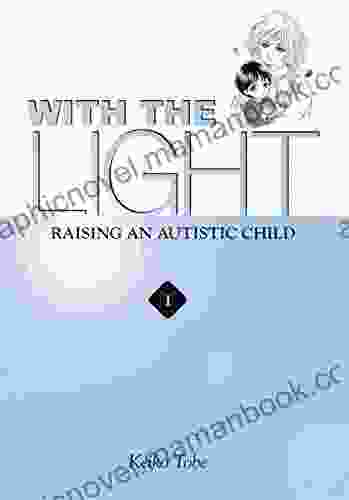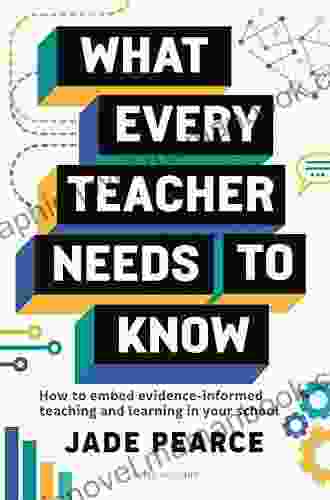The Essential Manual for Asperger Syndrome (ASD) in the Classroom: A Comprehensive Guide for Educators

Asperger Syndrome (ASD) is a neurodevelopmental disorder characterized by difficulties in social interaction, communication, and repetitive patterns of behavior and interests. Individuals with ASD may face unique challenges in the classroom setting, requiring educators to adopt specialized approaches to support their learning and well-being. This comprehensive manual aims to provide educators with essential knowledge and guidance on understanding, supporting, and empowering individuals with ASD in the classroom.
4.4 out of 5
| Language | : | English |
| File size | : | 2919 KB |
| Text-to-Speech | : | Enabled |
| Screen Reader | : | Supported |
| Enhanced typesetting | : | Enabled |
| Word Wise | : | Enabled |
| Print length | : | 226 pages |
Understanding Asperger Syndrome
- Definition and Characteristics: Define Asperger Syndrome and its key characteristics, including social difficulties, communication challenges, and repetitive behaviors.
- Spectrum of Severity: Explain the varying degrees of severity within the ASD spectrum and how it impacts individuals in the classroom.
- Co-Occurring Conditions: Discuss common co-occurring conditions associated with ASD, such as attention deficit hyperactivity disorder (ADHD),anxiety, and depression.
Communication Strategies
- Understanding Communication Challenges: Identify the specific communication difficulties faced by individuals with ASD, such as interpreting nonverbal cues, understanding sarcasm, and initiating conversations.
- Facilitating Communication: Provide strategies for facilitating communication, including using clear and concise language, reducing distractions, and using visual aids.
li>Social Skills Training: Describe evidence-based social skills training programs that can improve communication and social interaction skills in individuals with ASD.
Sensory Processing
- Understanding Sensory Processing: Explain how individuals with ASD may experience sensory stimuli differently, including sensitivities to light, sound, touch, and taste.
- Creating a Sensory-Friendly Classroom: Provide practical tips for creating a classroom environment that accommodates sensory sensitivities, such as reducing noise levels, using weighted blankets, and providing fidget toys.
- Sensory Interventions: Describe sensory interventions, such as sensory integration therapy and deep pressure touch, that can help regulate sensory processing in individuals with ASD.
Social Interaction
- Understanding Social Challenges: Discuss the social difficulties experienced by individuals with ASD, including difficulty understanding social cues, forming friendships, and participating in group activities.
- Promoting Social Inclusion: Provide strategies for promoting social inclusion in the classroom, such as using social stories, peer mentorship programs, and cooperative learning.
- Teaching Social Skills: Describe specific social skills that can be taught to individuals with ASD, such as greeting others, making eye contact, and engaging in conversations.
Academic Support
- Identifying Academic Strengths and Challenges: Assess the academic strengths and challenges of individuals with ASD, recognizing their unique learning styles and areas of giftedness.
- Differentiated Instruction: Provide guidance on differentiating instruction to meet the individual needs of students with ASD, including using visual aids, audiobooks, and hands-on activities.
- Assistive Technology: Describe assistive technology devices and software that can support students with ASD in the classroom, such as text-to-speech software, social skills apps, and visual organizers.
Collaboration and Advocacy
- Collaborating with Parents and Professionals: Emphasize the importance of collaborating with parents and other professionals, such as speech therapists, occupational therapists, and school counselors, to provide comprehensive support for students with ASD.
- Advocating for Students: Equip educators with strategies for advocating for the rights and needs of students with ASD, ensuring they have access to appropriate accommodations and support services.
- Professional Development: Encourage educators to engage in ongoing professional development opportunities to enhance their knowledge and skills in supporting individuals with ASD.
The Essential Manual for Asperger Syndrome (ASD) in the Classroom provides educators with a comprehensive roadmap for understanding, supporting, and empowering individuals with ASD in the classroom setting. By embracing the principles of inclusion, differentiation, and collaboration, educators can foster a learning environment that values and celebrates the unique strengths and needs of all students. This manual empowers educators to create a truly inclusive classroom where every student can reach their full potential.
4.4 out of 5
| Language | : | English |
| File size | : | 2919 KB |
| Text-to-Speech | : | Enabled |
| Screen Reader | : | Supported |
| Enhanced typesetting | : | Enabled |
| Word Wise | : | Enabled |
| Print length | : | 226 pages |
Do you want to contribute by writing guest posts on this blog?
Please contact us and send us a resume of previous articles that you have written.
 Top Book
Top Book Novel
Novel Fiction
Fiction Nonfiction
Nonfiction Literature
Literature Paperback
Paperback Hardcover
Hardcover E-book
E-book Audiobook
Audiobook Bestseller
Bestseller Classic
Classic Mystery
Mystery Thriller
Thriller Romance
Romance Fantasy
Fantasy Science Fiction
Science Fiction Biography
Biography Memoir
Memoir Autobiography
Autobiography Poetry
Poetry Drama
Drama Historical Fiction
Historical Fiction Self-help
Self-help Young Adult
Young Adult Childrens Books
Childrens Books Graphic Novel
Graphic Novel Anthology
Anthology Series
Series Encyclopedia
Encyclopedia Reference
Reference Guidebook
Guidebook Textbook
Textbook Workbook
Workbook Journal
Journal Diary
Diary Manuscript
Manuscript Folio
Folio Pulp Fiction
Pulp Fiction Short Stories
Short Stories Fairy Tales
Fairy Tales Fables
Fables Mythology
Mythology Philosophy
Philosophy Religion
Religion Spirituality
Spirituality Essays
Essays Critique
Critique Commentary
Commentary Glossary
Glossary Bibliography
Bibliography Index
Index Table of Contents
Table of Contents Preface
Preface Introduction
Introduction Foreword
Foreword Afterword
Afterword Appendices
Appendices Annotations
Annotations Footnotes
Footnotes Epilogue
Epilogue Prologue
Prologue Todd Whitaker
Todd Whitaker Rick Riordan
Rick Riordan Virginia Heath
Virginia Heath John Lawrence
John Lawrence Patrick Fagen
Patrick Fagen Glen Buckingham
Glen Buckingham John Cacavas
John Cacavas Joel Austin
Joel Austin Andrzej Sapkowski
Andrzej Sapkowski Cecelia Holland
Cecelia Holland Page Keeley
Page Keeley John Gomez
John Gomez Andrew Davis
Andrew Davis James Lee
James Lee Darlene Danaby
Darlene Danaby Marlon S Hayes
Marlon S Hayes Curt Thompson Md
Curt Thompson Md H A Guerber
H A Guerber G K Parks
G K Parks R S Thomas
R S Thomas
Light bulbAdvertise smarter! Our strategic ad space ensures maximum exposure. Reserve your spot today!

 Thomas PowellThe Greatest Love Poems and Quotes of All Time, Masterfully Illustrated: A...
Thomas PowellThe Greatest Love Poems and Quotes of All Time, Masterfully Illustrated: A... Pablo NerudaFollow ·16k
Pablo NerudaFollow ·16k Darnell MitchellFollow ·13.4k
Darnell MitchellFollow ·13.4k William WordsworthFollow ·13.4k
William WordsworthFollow ·13.4k Gerald ParkerFollow ·11.7k
Gerald ParkerFollow ·11.7k Roald DahlFollow ·19.7k
Roald DahlFollow ·19.7k Isaias BlairFollow ·10.2k
Isaias BlairFollow ·10.2k Brenton CoxFollow ·12.4k
Brenton CoxFollow ·12.4k Dion ReedFollow ·3.7k
Dion ReedFollow ·3.7k

 Rex Hayes
Rex HayesWorld of Dead Volume Issue: An In-Depth Analysis
The World of Dead volume issue...

 Nathan Reed
Nathan ReedHard Lessons Learned from ERP Rollouts: A Hivemind...
Enterprise...

 Fernando Bell
Fernando BellWith the Light, Vol. 1: Illuminating the Extraordinary...
The advent of parenthood is a...

 Wesley Reed
Wesley ReedNo Helping Hand: True Story of Deadly Waves
In December 2004,...

 Ruben Cox
Ruben CoxIntroduction to Electrodynamics by David Griffiths: A...
to Electrodynamics by...
4.4 out of 5
| Language | : | English |
| File size | : | 2919 KB |
| Text-to-Speech | : | Enabled |
| Screen Reader | : | Supported |
| Enhanced typesetting | : | Enabled |
| Word Wise | : | Enabled |
| Print length | : | 226 pages |












